The ancient civilization of Egypt was renowned for its complex religious beliefs, and at the heart of their spiritual practices were the numerous gods and goddesses that comprised the Egyptian pantheon. These deities played a fundamental role in every aspect of Egyptian life, from the agricultural cycle to the afterlife. In this article, we delve into the captivating world of Egyptian gods, exploring their significance, myths, and enduring legacy.

Ra (Re):
Ra, also known as Re, is one of the most important and powerful gods in ancient Egyptian mythology. He is the sun god, representing the sun's life-giving and illuminating qualities. Ra was believed to be the creator of the world, the ruler of the gods, and the ultimate source of life and light.
In Egyptian cosmology, Ra sailed across the sky in a solar boat during the day, providing warmth, light, and sustenance to all living beings. At night, he journeyed through the underworld, overcoming various challenges and threats, to rise again in the morning, symbolizing rebirth and renewal.
Depictions of Ra often show him as a falcon-headed deity wearing the sun disk, called the sun hieroglyph, on his head. Sometimes, he is shown as a man with a falcon's head or as a full falcon. This association with a falcon reflects the bird's connection to the sky and its ability to soar high above.
Ra's importance extended beyond the celestial realm. He was closely linked to the pharaohs, who were considered his earthly manifestations and ruled with his divine authority. The pharaohs were often referred to as "sons of Ra" and claimed a special connection to the sun god.
Over time, Ra merged with other deities, such as Amun, to form new syncretic deities like Amun-Ra, highlighting the changing religious landscape of ancient Egypt.
Ra's worship was widespread throughout ancient Egypt, and he had several temples dedicated to his honor, with the most prominent one located in Heliopolis. The cult of Ra played a significant role in Egyptian religious and cultural life, symbolizing the life-giving force of the sun and the power of divine kingship.
Isis:
Isis is a prominent goddess in ancient Egyptian mythology. She was revered for her various attributes, including motherhood, magic, wisdom, and protection. Isis was the wife of Osiris, the god of the afterlife, and the mother of Horus, the falcon-headed god.

Isis played a crucial role in the mythological narrative of Osiris. According to the myth, Osiris was killed by his brother Set, but Isis, with her magical abilities, managed to revive him temporarily to conceive their son, Horus. This tale symbolizes the cyclical nature of life, death, and rebirth.
Isis was often depicted as a woman with a throne-shaped headdress or with cow horns and a sun disk, symbolizing her divine nature. She was regarded as the ideal wife and mother, embodying qualities of nurturing and protection. As the mother of Horus, she was considered the protector of pharaohs and the symbol of divine kingship.
The worship of Isis extended beyond Egypt and gained popularity in various cultures, particularly during the Hellenistic period. Her cult spread throughout the Mediterranean, and she became associated with magic, healing, and wisdom. Isis was considered a powerful deity, invoked for guidance, protection, and assistance in matters of fertility and childbirth.
The cult of Isis remained influential for centuries and had dedicated temples and festivals throughout ancient Egypt. Even in the modern world, the image of Isis as a compassionate and powerful goddess continues to captivate and inspire.
Osiris:
Osiris is a significant deity in ancient Egyptian mythology, often associated with the afterlife, resurrection, and fertility. He played a central role in the Egyptian religious belief system as the ruler of the underworld and the judge of the dead.
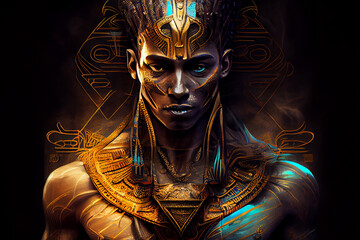
Osiris was revered as the brother and husband of Isis, the mother of Horus. He was the son of the sky god Geb and the earth goddess Nut, and the brother of Set, Nephthys, and Isis. As the god of fertility and agriculture, Osiris was linked to the annual flooding of the Nile River, which brought rich soil and abundance to the land.
One of the most well-known myths surrounding Osiris is his death and resurrection. According to the myth, his brother Set grew jealous of his power and murdered him, dismembering his body and scattering the pieces across Egypt. Isis, with her magical abilities, searched and reassembled the body, bringing Osiris back to life temporarily to conceive their son, Horus.
Osiris then became associated with the afterlife and the judgment of souls. He was depicted as a mummified figure, often with green or black skin, symbolizing rebirth and regeneration. In the realm of the dead, he presided over the weighing of the deceased's heart against the feather of Ma'at, the goddess of truth and justice.
The myth of Osiris emphasized the cyclical nature of life, death, and resurrection, serving as a source of hope and comfort for the ancient Egyptians. He represented the promise of eternal life and was believed to provide guidance and protection in the afterlife.
The worship of Osiris was widespread throughout ancient Egypt, and he had numerous temples and cult centers dedicated to his honor. The annual festival of Osiris, known as the Osiris Mysteries or the Festival of Khoiak, involved reenactments of his myth and rituals to ensure the fertility and prosperity of the land.
Osiris remains one of the most important and enduring figures in Egyptian mythology, representing the concepts of death, resurrection, and the promise of eternal life. His symbolism and influence extended beyond Egypt, with his cult spreading to other cultures in the ancient world.
Horus:
Horus is a significant deity in ancient Egyptian mythology, often depicted as a falcon-headed god. He played a central role in the Egyptian pantheon and was associated with kingship, protection, and divine justice.
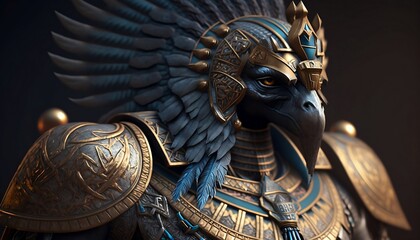
Horus was believed to be the son of Isis and Osiris, born after the resurrection of Osiris. He was regarded as the rightful heir to the throne of Egypt and symbolized the continuity of kingship. As such, the pharaohs were considered the earthly manifestations of Horus, representing the divine authority and power bestowed upon them.
One of the most well-known myths surrounding Horus is his battle against his uncle, Set, who had murdered his father Osiris and usurped the throne. Horus sought to avenge his father's death and reclaim his rightful place as the ruler of Egypt. The conflict between Horus and Set represented the eternal struggle between order and chaos, and Horus emerged victorious, becoming the embodiment of divine kingship.
Horus was often depicted with the head of a falcon and the body of a man. Sometimes, he was portrayed as a child or as a falcon itself. He was associated with the sky, symbolizing its vastness and the divine connection to the heavens. Horus was also closely linked to the sun and its life-giving properties.
The Eye of Horus, also known as the Wedjat or the Eye of Ra, was a powerful symbol representing protection, healing, and restoration. It was believed to bring divine intervention and ward off evil.
As the protector of the pharaohs and the embodiment of divine kingship, Horus was highly revered in ancient Egypt. His worship extended throughout the country, and temples dedicated to Horus, such as the famous Temple of Horus at Edfu, were constructed.
The mythology surrounding Horus and his association with kingship and protection left a lasting impact on Egyptian culture and society. The enduring legacy of Horus continues to capture the imagination, representing the divine and eternal qualities associated with ancient Egyptian beliefs.
Hathor:
Hathor is a prominent goddess in ancient Egyptian mythology, known as the goddess of love, beauty, joy, music, and motherhood. She played a vital role in the religious and cultural life of ancient Egypt and was one of the most widely worshipped deities.
Hathor was often depicted as a woman with the head of a cow or as a woman wearing cow horns with a sun disk in between, symbolizing her nurturing and maternal qualities. She was associated with femininity, fertility, and the protection of women and children. Hathor was regarded as the ideal embodiment of a loving and caring mother.
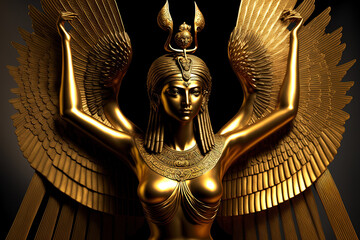
One of Hathor's significant roles was to bring happiness and celebration to the lives of the Egyptians. She was associated with music, dance, and festivities, and her worship often involved joyful rituals and performances. Hathor was believed to inspire creativity, and she was invoked during artistic endeavors and celebrations.
Hathor also had a role in the afterlife. She was considered a guide and protector of the deceased, helping them transition to the realm of the dead and ensuring their well-being in the afterlife. In this aspect, she was closely associated with the goddess Nut, who represented the sky and the journey of the soul after death.
Hathor's influence extended beyond Egypt, and her worship spread to other cultures, particularly during the New Kingdom period. She became associated with love and beauty in a broader sense, transcending geographical boundaries.
Temples dedicated to Hathor were constructed throughout Egypt, and her cult had a strong presence in places like Dendera and Philae. The Temple of Hathor at Dendera is particularly famous for its well-preserved reliefs and depictions of the goddess.
Hathor remains an enduring symbol of femininity, love, beauty, and joy. Her image and attributes continue to captivate and inspire, reminding us of the profound importance of love and celebration in human life.
Thoth:

Thoth was often depicted as a man with the head of an ibis, a long-billed wading bird, or as a baboon. These animal forms symbolized his connection to wisdom and the moon, which was associated with timekeeping and measurement in the Egyptian calendar.
Thoth was believed to have invented writing and was considered the scribe of the gods. He was credited with introducing hieroglyphics, the intricate system of writing used by the ancient Egyptians. As the patron of writing and record-keeping, Thoth played a vital role in preserving knowledge, documenting religious rituals, and maintaining the sacred texts.
In addition to writing, Thoth was associated with various forms of knowledge, including mathematics, science, and magic. He was believed to possess the secrets of the universe and was invoked for guidance in matters of wisdom, communication, and problem-solving.
Thoth was also closely associated with the judgment of the deceased in the afterlife. He was depicted in the "Weighing of the Heart" ceremony, where the heart of the deceased was weighed against the feather of Ma'at, the goddess of truth and justice. Thoth recorded the results of the judgment and played a role in the individual's journey into the afterlife.
The worship of Thoth was widespread in ancient Egypt, and he had dedicated temples and cult centers throughout the country. The most famous of these was the Temple of Thoth at Hermopolis, where he was venerated alongside other deities associated with wisdom.
Thoth's legacy transcended ancient Egyptian society, and his attributes and symbolism influenced later cultures. In the Hellenistic period, he was equated with the Greek god Hermes, blending Egyptian and Greek mythologies.
Thoth represents the pursuit of knowledge, the power of language, and the mysteries of the universe. His association with wisdom and magic continues to fascinate and inspire, highlighting the importance of intellect, communication, and divine insight in human endeavors.
Anubis:
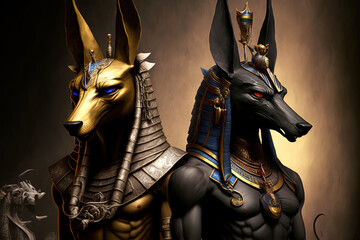
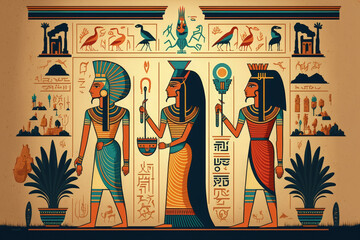
The pantheon of Egyptian gods represents a complex and intricate belief system that shaped every facet of ancient Egyptian society. From the sun god Ra to the nurturing goddess Isis, the enigmatic gods and goddesses of ancient Egypt embodied the hopes, fears, and aspirations of the people. Their myths, symbols, and rituals continue to captivate us today, revealing a profound understanding of the human condition and a rich tapestry of ancient wisdom that remains timeless.
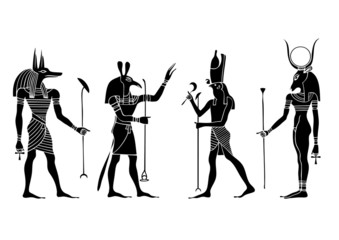




.jpg)
Comments
Post a Comment